In 1960, RK Narayan won the Sahitya Akademi Award for his novel, The Guide, published in 1958. The story is of a small town tourist guide who has an affair with the lonely wife of an archaeologist, an affair that has a lasting impact on his life.
Of course, anybody who knows anything about Hindi cinema would recognize the plot (and the name) immediately: this, after all, was (minus the ‘The’) the name of one of Hindi cinema’s most popular films ever made. The Dev Anand-Waheeda Rehman starrer Guide, directed by Vijay Anand, won an impressive seven Filmfare Awards (and that excluding what should definitely have been an award, for SD Burman’s brilliant score for the film).
But this is not that Guide. This is The Guide, the English-language film, directed by American director Tad Danielewski (who also wrote the screenplay for it, along with Pearl S Buck). Danielewski had been approached by Dev Anand, who was very keen on making The Guide simultaneously in both English as well as Hindi, with Chetan Anand directing the Hindi version. Almost as soon as shooting started—in Rajasthan, so much more exotic to the Western eye than South India—problems arose between the directors. Soon, Chetan Anand (whose Haqeeqat had just been given the go-ahead) moved away, and was replaced by younger brother Vijay Anand, who wrote the script for the Hindi version in three weeks flat. A version that was, ultimately, very different from the English-language one.
So what is The Guide all about?
The story begins in Udaipur, where the tourist guide Raju (Dev Anand) leads a group of tourists around the sights. He comes across as cocky (even if, like far too many Indian guides, he’s really not absolutely sure of the provenance of the sights he describes so confidently). He’s also somewhat slimy—he offers a tourist a chance to visit a dancing girl and enjoy himself—and yet also the sort of man whom the average gullible and helpless tourist would be happy to have along: Raju will do everything for you, from showing you a real cobra, with its fangs intact (not the defanged variety at the snake charmer’s), to tipping waiters at so-and-so restaurant.
A newcomer arrives at the town asking for Raju’s services. This is Marco (Kishore Sahu), an archaeologist. With Marco is his beautiful wife Rosie (Waheeda Rehman), who wants to see a cobra dance to the music of a flute.
Marco quickly spikes Raju’s guns when Raju attempts to show him the sights: Marco knows far more about these places than does Raju, and Raju is quickly sent off to attend to other things. Which Raju takes to mean looking after Rosie, whom he takes to see the dancing cobra. To Raju’s surprise—and wide-eyed pleasure—Rosie sheds her ‘elegant lady’ persona, hitches up her sari, and dances up a storm.
Raju is so infatuated by Rosie and her dancing that he even dreams of her. Raju’s mother (Leela Chitnis) comes rushing to see what’s wrong when Raju tosses and turns and talks in his sleep. She tells him a story—as she’s been doing since he was a child—to soothe him back to sleep.
The next day, Marco decides to set off for some caves which he wants to explore. They’re a good way off, a day’s journey, and Raju, along with a driver (Anwar Hussain) and a cook Joseph (Rashid Khan) will be going along. Raju wonders if Rosie will be going too, and Marco says, dismissively, that caves don’t interest her. But Raju, guessing that Rosie might like the environs, decides he will ask her anyway.
And Rosie, who does go along, loves the place, out in the wild. It’s beautiful.
Marco goes off exploring his caves (and soon shoos Raju away). Raju comes to Rosie, and shows her around. She tells him a bit about herself: she comes from a line of temple dancers, her mother and her grandmother were both temple dancers, but Rosie’s mother, by sending Rosie to school, made a dent in that tradition.
Raju is curious about how Rosie ended up married to Marco, and it turns out this was an arranged marriage: Marco advertised for an educated and beautiful bride—and got Rosie. He does not like her to dance, but dance is Rosie’s life, and that seems to have become the bone of contention between husband and wife.
Not that they seem to be otherwise happily married, either. They quarrel, they argue, they make up, says Rosie. For some days, it goes on quietly. And then they quarrel again. It’s obvious that these are two very different people, he a man obsessed with his work, she passionate about her dance but not allowed to even think about indulging in her passion.
That evening, as they sit on the terrace overlooking the jungle below, a leopard comes roaring out of the trees and attacks a deer far below. A terrified Rosie instinctively clings to Raju, who hugs her. Marco, watching them, shoots at the leopard, and looks as if he’d much rather have shot Rosie and Raju instead. A shaken Rosie cries out that she wants to go back to the hotel in Udaipur, and Marco, furious at what he’s just witnessed, agrees.
So the next day, leaving Marco to himself, Raju takes Rosie back to the city and to the hotel. And then, because—well, Rosie has shown that she’s not totally immune to Raju’s charms, and because Marco isn’t around either— Raju seduces Rosie.
In a post-coital haze of bliss, Rosie wishes aloud that she could dance again, and Raju supports her: he will be her manager. But no, Rosie has to put that aside. Because Marco will not agree.
All of this is interrupted by the sudden arrival of the driver, who comes banging on the door. He’s come all the way from the caves, because Marco has made a momentous discovery and has summoned Rosie. Rosie goes to the caves, and there is a showdown. The topic of Rosie’s dancing comes up again, and Rosie accuses Marco of not understanding her. In the course of the increasingly heated conversation, Rosie compares Marco to Raju (to Raju’s advantage) and, besides admitting that she has danced for Raju, also admits that she’s slept with him.
Marco, of course, is enraged. He gives Rosie the cold shoulder the rest of their time at the caves, and when it’s time for him to leave (Marco spends three weeks doing research), he gets into the train and goes—he hasn’t bought a ticket for Rosie.
So Rosie packs her bags and comes to Raju’s home. Raju is delighted, his mother is aghast, and the townspeople are soon up in arms against Raju for having had the audacity to live with a married woman. The little stall he owns (and runs with the help of a boy) at the railway station is summarily handed over to another man, and a crowd beats up Raju. Rosie comes to his rescue and takes him away…
… and decides that now that Marco’s out of her life, she can go back to dancing. She takes on the stage name ‘Nalini’ and debuts by performing—for free—at a school function, for which Raju helps her by approaching the school authorities on ‘Nalini’s’ behalf.
The performance is a huge success, and the next time we see her, Rosie is being feted. She’s the darling of all, performing far and wide, a celebrity. Raju, a now more urbane and suave Raju who keeps bottles of whisky in his safe, has a secretary, and hosts poker sessions every night, is still Rosie’s manager. He’s brusque, he’s money-minded (he insists that Rosie will be paid double what she was paid the last time, because this is the second time she’s going to be dancing for the same people).
But they’re drifting apart, and how. Rosie only wants to be with her ‘friends’: singers, musicians, dancers like her. And Raju, too caught up with his card-playing gang (with whom he also boozes and visits brothels) only thinks of Rosie as Rosie when he wants to spend the night with her; the rest of the time, she is Nalini, the means for him to make money.
Before they know it, their divergent paths have diverged so drastically that there’s no return for Raju or Rosie—and under what circumstances they will finally meet again is something neither of them knows now, or can guess.
Unlike its Hindi counterpart, which was an undoubted hit, The Guide sank without a trace. And it’s easy to see why; this is an uneven film, in many ways. It does have the elements that might have been expected to appeal to an American audience—‘exotic India’, with its painted and caparisoned elephants, its snake charmers and magnificent palaces included—but there is too much that’s also wrong with it.
What I liked about this film, and what I didn’t like:
Though that’s usually two separate sections in most of my film reviews, here I’m clubbing them together—because what I liked can pretty much be summed up in one sentence: the beauty of Waheeda Rehman.
On to what I didn’t like, which was a lot. One irritant was the somewhat stilted diction of a lot of the cast; most of them seem a little uncomfortable speaking English. It’s not just a question of accent, either: there’s just a sort of flatness of tone that comes with the unfamiliarity with a language. This, sadly, is most prominent in the case of Waheeda Rehman herself, who, though she was tutored by Pearl S Buck herself, comes across as uncomfortable with English—and it affects her acting. Iftekhar and Leela Chitnis are among the few actors whose English seems very natural: Dev Anand’s too, but because of his mannerisms, the effect is spoilt somewhat.
The other major irritant for me was the poor scripting. The Guide is a story that’s not as plot-driven as it is character-driven, and the problem with this screen adaptation is that in trying to fit it into two hours, Buck and Danielewski miss out on a good deal of character development. Things happen too suddenly and too abruptly to be convincing, and motivations are often unclear.
This becomes especially obvious (and annoying) in the middle of the film, when Rosie’s shift from being Marco’s neglected wife to being Raju’s lover and a famous dancer, occurs. Rosie seems to become famous overnight and without any hitches; Raju’s bringing her home seems to cause only the slightest of problems with the townspeople and a minor embarrassment for Raju’s mother; why they drift apart and how is not really shown. There are other sudden jumps, too: one moment, Raju is being given an offer by a lawyer and the next moment he is in jail, only—in the very next scene—to be out and free. If you don’t know the story already, it can be confusing and disconcerting, not to mention dissatisfying.
Comparisons, comparisons:
Let me, at the outset, admit that I’ve always been a bit of an iconoclast: I’ve never really liked Guide, except for some of its elements: SD Burman’s music is sublime, and Waheeda Rehman is beautiful, her acting is excellent, and so is her dancing. A lot of the rest—especially Dev Anand’s mannerism-ridden performance—has tended to put me off.
But, since I’d just watched The Guide, it seemed appropriate to rewatch its Hindi version too and compare the two. Of course, Guide is not The Guide, except in its basic story, its cast and most of its crew, and the settings. Vijay Anand scripted and directed a film that’s very different from what Tad Danielewski made.
On a macro level, there’s the very fact that Guide is more mainstream Hindi cinema than The Guide is (well, naturally). For one, Guide has songs—and what wonderful songs, too—while The Guide has, except for one very brief, almost wordless (?) ululation by SD Burman at one point near the end, nothing by way of song (in fact, very little in the way of dance, too).
Also, since Vijay Anand knew Indian society and Indian audiences, he introduced nuances and details that would fit the audience and its tastes.
Rosie, for instance, doesn’t plunge into an affair with Raju simply because Marco neglects her and doesn’t want her to dance. No, Marco is a despicable man: he drinks, he has a whore visit him at the caves, he hits Rosie, he calmly (and triumphantly) admits that he married her for her body, nothing else. Rosie is battered, suicidal—and her relationship with the only person who’s sympathetic and understanding and supportive (Raju) arises out of this. So even though a Bharatiya naari shouldn’t be in an adulterous relationship, some justification is built up for it.
Then, too, even when she’s moved to Raju’s home, the impact of that relationship is very widespread, and not merely confined to Raju being beaten up and deprived of the stall at the railway station. It’s a rather more virulent boycott of the two—and yet, from the conversations between Raju and Rosie, the implication is that they aren’t actually sleeping together, even after he’s managed to set her on the path to success.
Near the end, Guide takes even more of a catering-to-the-average-Indian turn: where the American film’s guide slowly grows weaker and struggles with his conscience now and then, the Hindi film’s guide sees his two alter egos battle it out: one, the self-serving, opportunistic Raju, the other a sanctimoniously radiant, saintly being clad in a shimmering saffron cloak, who talks about how his body may die, but he will remain. There is no leaving it to the audience to figure out what dilemma Raju is facing, what demons are battling it out within this man; you’re shown it.
But, to cut to the chase: while I do not much like Guide, I still think it’s a far better film than The Guide. The Guide is bogged down by a script that does not do a good job of depicting the character arcs of its protagonists; it leaves out a lot that could have helped define Raju and Rosie better. Guide, on the other hand, does a more impressive job of showing how they first come together and then what makes them drift apart. Watch The Guide only if you, like me, are curious to see what they did with the English version.
You can watch The Guide on Youtube, here.


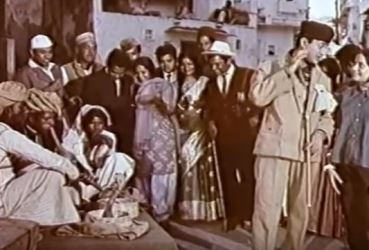
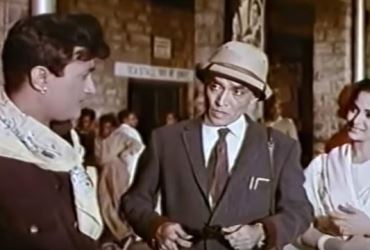
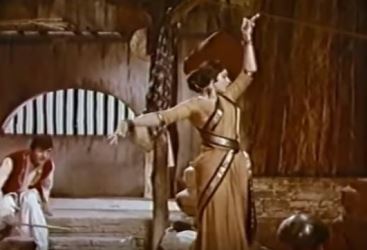
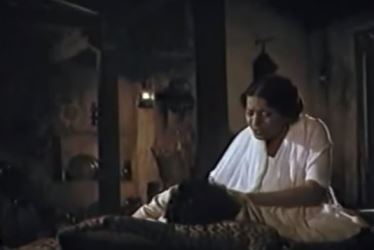
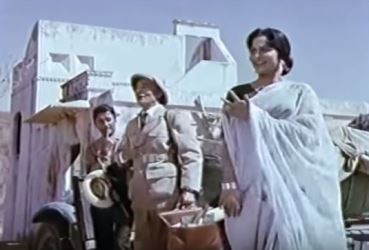



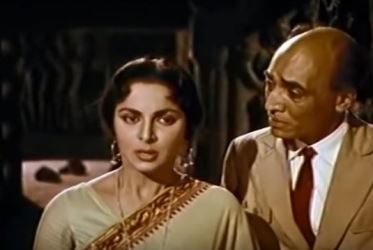
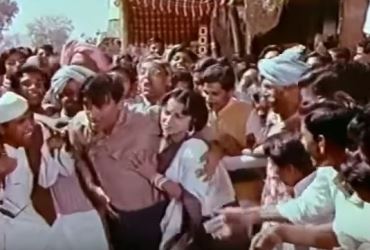
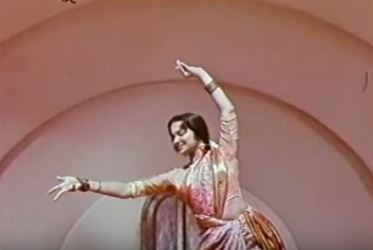

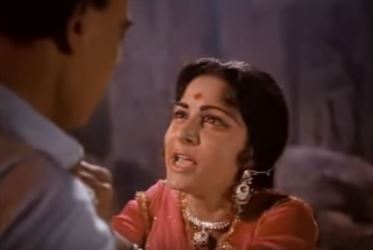

As usual, a crackling review! I share your iconoclasm, never warmed to Guide either. The truth be told, I’ve not seen the English version fully, even though I posted the link on Facebook (and tagged you). The stilted diction simply did not work for me. It’s not just about accents, actually. It conveys the impression of a badly rehearsed school play, where the cast is so valiantly trying to remember their lines they forget just what kind of feelings they need to invest in them.
LikeLike
Thank you! And yes, I totally agree about the point you make about not-accents. The cast – barring Iftekhar, who I think came across as a natural and whom I’d loved to have seen in a larger role – all do seem to be focussing so much on their lines that they forget to include the feelings. Rather like Leela Naidu in Hindi cinema, I thought (ironically enough, since some say that she was initially considered for the role of Rosie).
LikeLike
Agree with you. It’s a film I could never rewatch – mostly due to Dev Anand. And the poignancy of S D Burman singing Wahan kaun hai tera – just too emotional. The music is sublime.
I was struck with how much the film differs from the book – R K Narayan doesn’t pull any punches about his characters’ higher motives.
LikeLike
I have to admit I’ve not re-read the book since Class XI, when we had to study it. And I don’t remember very much of it, though I do recall not liking any of the characters – which probably echoes your remark about Narayan not pulling any punches about his characters’ higher motives. I think, in that sense, the English film is perhaps closer to the novel than is the Hindi one: a pity it wasn’t better scripted.
LikeLike
I have seen The Guide in 2012 or 2013 when the print was bought by some friends – paying quite a hefty amount you see – from a collector. I did not have to pay; a friend gave it to me for free. The music of The Guide was mostly RD’s doing – it is all background (have mentioned it in my SD book), and that was my primary interest in seeing the film. I did not find that The Guide has repeat value.
And now I cannot find the print !!!
LikeLike
I agree with you about not finding any repeat value in The Guide; it’s a very forgettable film. Hadn’t known that the background music was all mostly RD’s – or had forgotten, since I’d have read it in your book. :-)
LikeLike
You have summed up well. Though Guide was tom tommed as a great film, it did not amount to much. Dev Anand was known to portray some urban characters with an amoral and negative streak , but he never stooped to this low level. It is a surprise how Waheeda Rehman too agreed to portray such a character.
This film was star-crossed from the beginning. R.K.Narayan himself wrote a long article in the American magazine ‘Life” tearing the makers of the English version to pieces. Dev had good intentions and was known as a gentleman. He met RKN to finalise the deal.But something happened along the way. The English version came in for scathing attack by RKN. Pearl Buck was writing the script. They attempted to tap Lord Mounbatten to get the British Royalty interested in the project. RKN describes, with obvious relish the fiasco of Pearl Buck’s attempts to describe the story to Lord Mountbatten.Director Tad Danielewski had his share of misdeeds. For example, for a scene lasting a few seconds, he wanted to show a tiger killing a goat. The goat was tied up in front of the tiger, and it kept bleating all right or day, and the tiger did not kill it. The men killed it and fed it to the tiger! Where was the need to show such ugly violence ? RKN had taken the producers to show places around Mysore-Nanjangud on the banks of river Kabini – the place he had had in mind. They all agreed that it was good, but finally chose Rajasthan! As if the gods themselves would not take it, the first set they had erected in Rajasthan was washed away in rain fury! RKN recounts these events with some relish, I suppose! This article is now reprinted in an anthology of his essays published by Penguin.
The Hindi version too had its share of troubles. After Chetan Anand left, Raj Khosla was to be the director. But Waheeda Rehman would not have him. It seems in C.I.D, he had insisted on Waheeda wearing some dress which she considered indecent. The matter went to GuruDutt the producer, but even he could not make Waheeda change her mind. And this was her first big movie, though in a negative role! So she did not want to work with Raj Khosla. They then contemplated replacing Waheeda Rehman but finally felt that the dances demanded her! So Vijay Anand was roped in as director. He too had misgivings as this was a story of adultery at base and he was not sure how Indian audiences would take it. Finally he made it.
The music of the Hindi version is hailed, but personally I do not like it much. SDB had given more pleasing and scintillating music in other Navketan movies earlier. But by mid-60s standards, it was not bad. And SDB was hugely disappointed in not getting the Filmfare award – it went to Shanker Jaikishan by manipulation for much inferior music in Suraj! [ A similar thing had happened to Naushad in respect of Mughal E Azam! Raju Bharatan had recounted these in his books.]
Somehow, I did not like Guide. It is a story of pure adultery, though glorified by colour and good music. [ Such a theme is not foreign to Hollywood. ‘ Love Is A Many Splendoured Thing’ is also a story of adultery]. And even Dev ceased to interest me after that. This was obviously a film that was not true to the spirit of the story, or to the author. I could not sit through the movie in the theatre when it was first released, and walked away in the middle!
LikeLike
Thank you for that informative and insightful comment.
It’s been many many years since I read The Guide, but I think in one sense, the English film does manage to stay true to RK Narayan’s book, in that it does not make its characters out to be great – or even good – people. The problem with the Hindi film is that it tries to straddle the path between commercially viable (the music, the romance between the main characters, various dilemmas they face) and the bold – with the result that the adultery, as you mention, is glorified. From what I recall of the novel, that is not the main crux of the story at all.
LikeLike
I recollect one more incident connected with this movie. Hasrat Jaipuri was the original lyricist. During the discussions on one song to be picturised on Dev Anand, director Vijay Anand was not satisfied no matter what Hasrat came up with. It seems finally in exasperation, Hasrat burst out : Ek bhadve ke liye aur kya likun? and left . Then Shailendra was brought in as the lyricist. Due to his regard for his friend and colleague Hasrat, Shailendra retained the opening line. I forget the exact song now, but Raju Bharatan has mentioned it in his book.
LikeLike
That’s interesting! I wonder which song that was.
LikeLike
I have found out the song! It is: Din dhal jaaye haaye raat na jaaye ! This is mentioned on page 55 of Raju Bharatan’s book:” A Journey Down Melody Lane” (Hay House, 2017 reprint)
LikeLike
Thank you so much for taking the trouble! That’s interesting.
LikeLike
Hello Madhuji,
A good review, I haven’t seen of course the English version. And when I realized about the changes the Guide team had made in the original story by Mr Narayan, I started disliking the Hindi version too.
Just because our Hindi film hero can’t be a bad guy or of gray shade, the story was altered to suit Indian audience. But the original story hasn’t mentioned Marco as having extra marital relationship. And original story portrays Raju as a lustful man.
The main attraction of Guide is songs, wonderful adorable melodious songs by Burmanda.
The Guide is devoid of songs too, then not much interesting to me.
LikeLike
Agree about what you say about altering the story to suit the Indian audience (another alteration is that in the end – the novel leaves it ambiguous, but the Hindi film ends with his death, thus providing him some redemption). I think there’s too much changing in the story to make it what it originally was supposed to convey: not a doomed, forbidden romance, but a somewhat quirky, somewhat tragic story of a man whose life takes some very unexpected turns.
I love the songs of the Hindi film. All of them are beautiful.
LikeLike
Madhu,
I have not seen ‘The Guide’, nor do I intend to after your very helpful review. Its makers must have goofed up badly that the film sank. With this kind of story, the English version should have worked, and the Hindi version should have faced problems. Besides the music, dances and the script, the final redemption of the sinner must have impressed the Indian viewers.
AK
LikeLike
I have a feeling that this was a badly planned film when it came to the English version. Would American audiences back then really have been ready for a film that was all Indian when it came to cast? True, there had been films set in India, and even with the once-off Indian actor (IS Johar comes to mind, Shashi Kapoor too), but a wholly Indian cast, and that too one which sounded painfully ill at ease speaking English? And added to that, a bad script… if the script had been good, and the actors’ English good, it might have had a chance. But the same film wouldn’t have worked in India – the song and dance and the reworking to justify adultery and give Raju redemption through death – was needed. I think SDB and Waheeda’s dancing played a major role in the success of the Hindi film.
LikeLike
Thanks for the review and the comparison, Madhu. I didn’t like the Hindi film much -barring some songs and Waheeda Rehman’s dances – especially because it differed from the book so much. Wasn’t ever keen about watching the English version, mainly because I had read (in a collection of personal essays by Narayan) that the entire experience had left him extremely disillusioned with the film world. Promises made to him were blatantly broken and he did not like the final script and did not wish to be associated with either the Hindi or the English version.
LikeLike
I do recall reading (though now I don’t remember where) that RK Narayan was so upset that he disowned Guide. It’s been many years since I read the book, but from what I recall, the tone is very different, no? It’s not a story of redemption at all. What the Anands did was to make it a typical Hindi film, anti hero-heroine, redemption, lots of song and dance, etc. Yes, a bold and unusual twist when it comes to the adultery angle (not that adultery hadn’t been shown before, even by a woman – Yeh Raaste Hain Pyaar Ke is one – but I guess they realized that if they wanted to swing this one, they would have to tweak story and characters a good deal.
I’m glad to see I’m not the only one who doesn’t like Guide! ;-)
LikeLike
I’ve been trying to find a copy of this film forever, thanks for the YouTube link!
Speaking of English versions of Bollywood films, have you seen ‘Raiders of the Sacred Stone’, the English version of the Dharmendra/Zeenat Aman/Rex Harrison film, ‘Shalimar’?
LikeLike
You’re welcome! And no, I haven’t seen Raiders of the Sacred Stone – I didn’t even know about that. Any good?
LikeLiked by 1 person
I’ve never watched it actually even though I have a copy of it, lol!
LikeLike
Hehe! Does it have Dharmendra, though? Because somehow I cringe at the thought of hearing him speak English…
LikeLiked by 1 person
Yeah, I think it’s all the same cast, just all speaking English, lol!
LikeLike
Oh, Lord. Dharmendra, while someone I find very handsome (though going downhill in Shalimar), is best not heard speaking English. ;-)
LikeLiked by 1 person
Madhu ji ,
I liked the review . A perfect one .
I too had studied the novel in college nd had scored good no.of marks by writing its analysis .
But I was very wonderstruck when I watched the movie afterwards .
It had so many changes .
Keeping the novel aside , I enjoyed the hindi version .
But I must say that the theme which the author has to put forth , is well crafted in the English movie ” It is the story of a guide who misguided himself while guiding others . It is the story of rise nd fall of a common man . ”
Dev had played many negative shaded roles . This was the best .
Madhu ji , I agree with the comparisons nd the conclusions U had drawn .
Thnx for a very nice write – up .
LikeLike
“It is the story of a guide who misguided himself while guiding others . It is the story of rise nd fall of a common man.”
That’s very well put! Thank you, Pramodji. Glad you enjoyed this review. It’s been many many years since I read the book (I had to study it in Class XI), and there was such a long gap between my first viewing of the film (long before I read the novel) and my subsequent viewings of it (long after I read the novel) that at this stage it’s impossible for me to compare the two (and someone permanently ‘borrowed’ my copy of The Guide, so I couldn’t even read it this time!).
LikeLike
I’ve watched a bit of the English version, but as you say several of the characters (especially Waheeda) sound stilted and are so fixated on delivering their lines, that they’ve forgotten to emote. I really enjoyed the Hindi version when I saw it some years ago. A lot of the comments label Dev and Waheeda’s relationship as an ‘adulterous’ one. I don’t recall any adultery in the movie. If I remember correctly, Rosie had made a clean break with Marco before she took up with Raju. There was an undercurrent of attraction between them before that, but neither of them sought to act on it. What she got from Raju was companionship and support during a low point in her life. Even after she walked out on her husband and was living with Raju, the exact nature of their relationship was deliberately kept ambiguous, keeping audience sensibilities in mind. When they were living together, she was seeking an official divorce from Marco. I think before the ‘Tere Mere Sapne’ song, Raju tells her that it would have been wrong for her to enter into a relationship with him earlier, but that the circumstances were now different given that she was permanently leaving her husband. Leaving your husband to pursue a career as a dancer was certainly a very unconventional thing to do, but I don’t think adultery was at the core of the story. I think it unlikely that the film would have been such a huge success if it had been.
LikeLike
I think the labelling of Rosie’s relationship with Raju as ‘adulterous’ is because she does take up with Raju before divorcing Marco (does the divorce actually even come through?). And, frankly speaking, most Indians back then – probably even today – would say that even if a woman’s divorce is on the way, she shouldn’t be with another man. I don’t agree with that, but that’s possibly how many people perceived it (there is someone else who’s commented on this post, remembering how appalled he was by the premise and walked out of the cinema hall without even watching the entire film).
It is my opinion that the star cast and the music, as well as Waheeda Rehman’s fabulous dancing, went a long way in making Guide so popular. Plus, of course, the fact that Vijay Anand does tailor the script somewhat to an Indian audience, by sort of justifying Rosie’s leaving Marco, as well as giving Raju redemption, finally.
LikeLike
Redemption for the drinking and gambling he indulged in after becoming wealthy and heady with success perhaps. The redemption was not for taking up with Rosie. The film upholds his actions. The makers sought to underline that he was not some unscrupulous rake seeking to seduce a married woman. Initially, he was shown trying to patch things up between Rosie and Marco, telling Rosie that Marco was anxious for her to join him at the caves. Rosie’s separation from her husband was premised on her wanting to pursue her passion, as well as her unhappiness in her marital situation (callous husband, no kids, sense of emptiness etc). She did not leave Marco to be with Raju per se. She went with Raju, when he offered his love after she had already left Marco. It’s true that she was not actually divorced at this stage, but the carefully constructed sequence of events are such that neither of them come across as engaging in an adulterous relationship. The songs and stars certainly contributed to the film’s success, but I think that most of the audience members liked and empathised with both the main characters, and did not view the film as a glorification of adultery.
LikeLike
I have no idea. :-) I suppose until one actually asks a wide cross-section of the audience from back then what they thought and why they liked the film, we can only conjecture.
LikeLike
This film on the internet is a result of my finding. I had uploaded in my channel but it was blocked hence I created a new channel where I uploaded this film, someone (called Rohit) took the video from that channel and uploaded it on his channel. The film on his channel grabbed more views than mine, though I have no problem if he uploaded that film on his channel, afterall no one owns the film.
LikeLike
Oh, I’m sorry that happened to you. :-( And thank you for uploading it in the first place. Grateful to you for giving us access to this film – I’ve long been curious about it.
LikeLike
Most welcmoe :)
LikeLike
@Voice from the past: I watched all this happening and thought that this was so ironic…You did the work and someone else got the attention and the praise… – After your upload, I shared your link with some fellow film enthusiasts, but only via dm, thus hoping to keep your upload safe from being blocked. Glad you put things straight here :)
LikeLike
I think this sort of things happens frequently. Tom Daniel, who’s done a brilliant job of digging up and restoring dozens of (often very obscure) old Hindi films, has had his videos passed off as their own by countless people. The internet is a place of little ethical sense. :-(
LikeLike
So, I had read and heard about the English version of “Guide” but never thought I would watch it. Your review sort of intrigued me to a point that I should try it, though you had fair bit of warning all the way. I struggled to watch for 30 minutes and then gave up. Agree with you that this is painful watch mainly due to language. It is not conversational at all, how it should be. It is exactly like Abhik said, sounds like a play, reading out loud the lines from a script. It is terrible including Dev whom I thought knew the basics of acting… I remember a Shashi Kapoor movie you recommended (A matter of innocence) where Shashi was much more natural and he is not even recognized for his acting.. I certainly didn’t expect Dev to be so ordinary..
Going to the original Hindi Guide, I have always had mixed feelings about the movie keeping super melodious music aside. I wasn’t able to quite get into the minds of Raju and Rosie. At times feeling bad for Raju for losing whatever he had and putting his life on hold for Rosie, on the other hand his greedy behavior along the way.. Or understanding Rosie for she was not much invested in Raju though he was sort of the catalyst she needed. Not sure I fully understood either of those characters. Haven’t read the novel either so I don’t know if this is a matter of interpretation of characters or this is how the characters were meant to be. Yes, people can be complicated at times, to fully understand their actions and perhaps I am lost in the analysis-paralysis..
One thing is pretty clear to me – your review is spot-on! Thank you!
LikeLike
I agree with you about even Dev Anand sounding so stilted. I remembered Sidharth Bhatia, in his book on Navketan, mentioning that Waheeda Rehman’s English wasn’t good enough so Pearl S Buck tutored her – so I’d been prepared for that; but considering Dev Anand was so fluent in English, the odd diction even he adopted came across as very false. Abhik put it well!
As far as the Hindi version is concerned, too, I feel that the characters and their motivations are not very consistent. Near the beginning, when Rosie is so suicidal (Raju rescues her thrice), she bounces back very quickly and is happily chatting with Raju soon after – not the way someone so depressed would behave. And later in the film, too, I find it irritating that Rosie and Raju, despite all their love for each other, find it so difficult to express their feelings: Rosie’s hints about how she’s feeling used by him are all so horribly oblique. Yes, grey characters are all very well, but these two didn’t make me feel for them.
LikeLike
Completely agree! My thoughts on the movie are very close to yours. Have not seen the English version but never did think very highly of Guide. It has its moments though. The music is amazing as is Waheeda Rehman. Could not agree more with your review :-)
LikeLike
Thank you! Yes, Guide does its moments – and Waheeda Rehman and the music are worth watching, but overall it’s not a great film.
LikeLike
Padmini were Leela Naidu were first choice to play heroine. Padmini was rejected as shevwas too buxom. I dont know why leela naidu was rejected.
LikeLike
I have no idea. I didn’t even know about Padmini being in the running – but Sidharth Bhatia, in Cinema Modern: The Navketan Story quotes Dev Anand as saying, in an interview, that even Leela Naidu was never considered and that it was always Waheeda Rehman as far as the Anands were concerned. Though Bhatia does offer an explanation for why Leela Naidu wouldn’t have fitted the role: she wasn’t a dancer.
LikeLike
Waheeda Rehman spoke this in an interview. Padmini wrote letter nd made phone call to waheeda to speak about this. I dont remember the interview. It was five years back.
LikeLike
It makes sense, actually, given that Padmini was such a good dancer.
LikeLike
I have watched the English version 3 times now, and I have to say that it loses with every rewatch. So many plot holes, and the last scenes drag on and on.
But I still think it was worth my time and I recommend to watch it.
Why?
Well, it’s not an overwhelmingly good film, just kind of okay-ish. But there definitely is a lot to learn from it when you compare it to the Hindi version and to Indian Cinema in general. All those people – especially in the West – who continously critizise Indian films for being too long, for being escapist by having song and dance sequences etc etc…well, go and see what happens when these elements are missing. When a film does NOT take the time that is necessary to develop a relationship for example, or when a film that is to a large extent about a dancer has so little dance and hardly any music…then you will sit and YEARN for these things just as the villagers long for the rain!
Also I liked that the characters were closer to the book, more realistic, not just a hero-love interest-villain triangle.
I loved to see Rosie as a character of flesh and blood, far from perfect, but still lovable and relatable. And the film took the Rosie/Marco couple issues seriously while the Hindi version was just melodramatic (and I HATED the suicide attempt scenes. Very bad taste.)
I’m in awe of what Waheeda Rehman dared in the English version, even a scene in bed with Raju, and she acts as if this was nothing in early 60s India! Hats off to her courage; it makes me forgive her bad English, even it that takes away some of the dialogue’s poignancy.
Dev Anand was charming enough as Raju the Guide but he also made it clear that in Raju’s world, Raju would always come first. Sometimes he reminded me of Tony, the chilling anti-hero in Guru Dutt’s “Jaal” (maybe THE role that was Dev’s venture on character acting?).While in the Hindi version he wants to be hero, nothing else.
So, even if the outcome is mediocre, I appreciate the will to try new, different things instead of playing it safe.
LikeLike
“Also I liked that the characters were closer to the book, more realistic, not just a hero-love interest-villain triangle.”
I think that’s what I liked the most about this film – it does not adhere to the formulaic Hindi film (or even, for that matter, much of Hollywood back then) characterisation and is therefore closer to the book.
Thank you for the long and detailed comment, Manuela. That made for very interesting reading. :-)
LikeLike
That’s an excellent comparison of the two different celluloid versions of the extra-ordinary story by R.K. Narayan. Very objective and to-the-point analysis, I must admit. You have rightly emphasized the significance of the immortal music of the Hindi version. I feel that Kaanton Se Kheench Ke Ye Aanchal is the song which sets the tone of the real story and highlights the key change in Rosy’s personality, mindset and, consequentially, life.
I have found that while talking about this movie, most of the people ignore the performance of Kishore Sahu in the role of Marco. In my humble opinion, Kishore Sahu can be counted among one of the most underrated Bollywood film personalities (both as an actor and as a producer-director).
LikeLike
Thank you. I’m so glad you liked this review.
And yes, I agree re: Kishore Sahu. Much more than the more well-known roles of his, I am impressed by his Hamlet: it’s so interesting to see Shakespeare translated into Hindustani, with the characters and costumes and everything else pretty much retained as it is. That, for me, is the most memorable Kishore Sahu production and role.
LikeLiked by 1 person
Brilliant analysis. I just finished reading the novel. I think R k narayan wasn’t happy with the cinematic liberties taken by the anands.this is the problem with most writers. They have a completelt different vision from that of film makers. The novel is more engaging and unputdownable. Surprising that it was included in college syllabus despite its bold theme.
Rosie is very clear about what she wants from life. She doesn’t even visit the swami when there is so much media coverage about the swami’s fast. After all, she has shifted from malgudi to chennai. Even raju’s mother only meets him in the court. In the novel, no character is shown as straightforward including raju’s mother, the car driver gaffoor or even joseph, the cook. All characters appear real and display shades of grey. Rosie never attempts suicide even in the.most trying circumstances. Neither is Marco a lecher. There are subtle hints that Marco is not intersted in sex. He is someone who is so much all about himself and denigratres dance as something that is cheap. In the novel there is no mention of divorce between marco and Rosie. After raju is caught in the forgery case, Rosie leaves both of them. In fact, one of the reasons raju commits that forgery is because he gets possessive about rosie and cannot stand it when she expresses remorse about leaving her husband. Unlike the movie, in the novel it is clearly shown that raju is smitten by her right from the very beginning. R k narayan has desribed the love making in a very subtle manner. Yes, the novel is not about a doomed romance at all. It is about a man who wants everything easy in life…right from his childhood days. This is the reason why he settles down near the temple after his release from jail.
Btw when you read the novel it is clear that rkn is describing mysore when he refers to malgudi.
LikeLike
Yes. I don’t remember the novel very well – I had to study it in school, and have never re-read it – but I do recall that the film was very different in its essence.
LikeLike
Hello everyone,
My views are a bit contrarian.
1. All those who are watching the film for free in you tube are behaving like arm chair critics.
2. The Guide is not all that bad. It has closely followed R K Narayan’s novel.
3. There are some changes that Tad has made that may have disappointed R K Narayan but why did he get so flustered is beyond my comprehension.
4. Yes, I agree that Waheeda’s dialog delivery looks a bit odd despite the fact that she was groomed by Pearl S Buck herself.
5. But just spare a thought – my dear friends – film making is a huge effort. Even Guide didn’t find favor with the American audiences, it is still a film that can be watched.
6. I found it quite fast-paced and may be because I just finished reading the novel on 27th July 2019 (due to a severe joint ache that confined me to my bed) and saw the film on 29th July 2019, I could connect with it. Those who haven’t read the novel and have watched The Guide may find it a bit disjointed.
7. In the novel, Rosie alias Nalini never meets the guide-turned-swami till the end. Whereas in the movie, the makers have made Rosie visit Raju to persuade him to come with her back (after all that that transpired between the two). This is a serious anomaly and may be this irked R K Narayan.
8. The English movie stays remarkably close to the novel as compared to the Hindi version. Therefore it surprises me that the author was upset. Yes, I agree that setting the film in Rajasthan was ironical. Velan is a Tamil Name. If the film had had a Southern milieu it would have sounded more authentic.
9. K N Singh, Leela Mishra and most other character artistes have spoken English reasonably well.
10. The screenplay is taut – according to me – because it moves the narrative at a faster pace.
11. From where the makers managed to gather such huge crowds?
12. The film was shot in 8 weeks flat. Great, isn’t it?
13. The background music is splendid – it gave a unique feel to the film.
14. If we do not read too much meaning into RKN’s novel, we shouldn’t read too much meaning in the film’s script as well. The script has been derived from the novel!
15. The novel did not make any references to Raju sleeping around with other women. The film portrays him as a lustful creature.
16. The last scene in the movie is straight out of the book.
17. I do not know why the male American journalist was converted into a female journalist.
Just look at it – a guide who falls in love with a married woman. The woman is in a loveless relationship with her husband who gives a damn to her dancing abilities. The woman sleeps with the guide and he in turn promises her to showcase her dancing skills to the world. But he becomes way too greedy in the process. Love flows out of the window. The woman still has a soft corner for her husband – she doesn’t divorce him but continues the affair with her lover-cum-mentor till a particular point. Incensed by the feelings that she expresses for her husband, the guide-turned-mentor commits a forgery and is jailed. She spares no effort to rescue him and his sentence is reduced from 7 years to 2 years. But Rosie aka Nalini is very clear that she had had enough with her mentor and snaps all ties with him. Rosie’s empowerment is never shown in The Guide. While Raju had always thought that he was indispensable for Rosie, the latter felt that she could sustain her career on her own steam. For Rosie, Raju is a closed chapter in her life. After his release from jail, Raju is too lazy to work and finally he meets his nemesis as a swami / yogi.
Kudos to R K Narayan for portraying the complexity in human relationships. We are all discussing his story and film so much 61 years after it was first released- isn’t that proof of his creative mastery and foresight?
Last but not the least, I LIKED The Guide. Period.
LikeLike
That is a long comment, and very comprehensive. Yes, I can see that you analysed this film (in both its versions) and the novel very thoroughly. And that you liked it a lot.
LikeLike